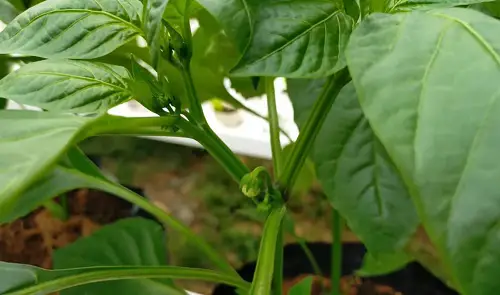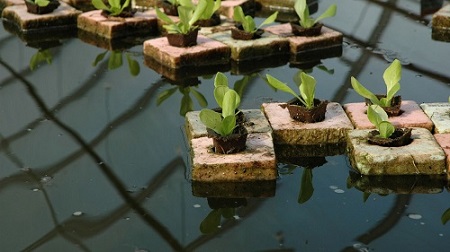Hydroponic bell pepper farming is a great way to produce fresh, healthy peppers all year round. Unlike traditional soil-based farming, hydroponics provides a controlled environment for plants, which allows for more efficient and effective growth. In this article, we’ll go over everything you need to know about growing hydroponic bell peppers, from setting up a hydroponic system to harvesting and storing your peppers.
Benefits of Hydroponic Bell Pepper Farming
There are several benefits to growing bell peppers using hydroponics, including:
- Increased yield and faster growth: Hydroponic systems provide a consistent supply of nutrients and water to plants, which allows them to grow faster and produce more fruit.
- Year-round production: Since hydroponic systems are not dependent on weather conditions, you can grow bell peppers all year round.
- Space-saving: Hydroponic systems take up less space than traditional farming methods, making them ideal for urban and indoor farming.
- Reduced water usage: Hydroponic systems use up to 90% less water than traditional farming methods, making them more environmentally friendly.
- Fewer pests and diseases: Hydroponic systems are less prone to pests and diseases, which reduces the need for pesticides and other chemicals.
Setting up a Hydroponic System
Before you start growing hydroponic bell peppers, you need to set up a hydroponic system. Here are the steps you should follow:
Choosing the Right Hydroponic System
There are several types of hydroponic systems to choose from, including deep water culture, nutrient film technique, and drip irrigation. Each system has its own advantages and disadvantages, so it’s essential to choose the right one based on your needs and resources.
Selecting the Right Location
The location of your hydroponic system is critical. You need to choose a location that has access to electricity, water, and adequate ventilation. It should also be away from direct sunlight and extreme temperatures.
Installing and Maintaining the Hydroponic System
Once you’ve chosen the right system and location, you need to install and maintain the hydroponic system. This involves setting up the water pump, air stone, and nutrient reservoir. You also need to monitor the pH and nutrient levels regularly and adjust them as needed.
Choosing the Right Bell Pepper Varieties
There are several varieties of bell peppers to choose from, including green, red, yellow, and orange. It’s essential to choose a variety that is suitable for hydroponic farming and your local climate.
Preparing the Bell Pepper Seedlings
Preparing the bell pepper seedlings is a crucial step in hydroponic bell pepper farming. Here are the steps you should follow to prepare your bell pepper seedlings:
- Start with high-quality seeds: The first step is to start with high-quality bell pepper seeds. You can buy seeds from a reputable supplier or save seeds from mature bell peppers.
- Germinate the seeds: To germinate the seeds, place them in a seed-starting tray filled with a seed-starting mix. Keep the tray in a warm, humid place, and make sure to keep the soil moist.
- Transplant the seedlings: Once the seedlings have emerged, transplant them into larger containers filled with a growing medium, such as coconut coir or perlite. Make sure to handle the seedlings carefully to avoid damaging their delicate roots.
- Provide adequate lighting: Bell pepper seedlings require plenty of light to grow properly. You can use artificial lighting, such as fluorescent or LED lights, to provide the necessary light.
- Monitor the seedlings: Keep a close eye on your bell pepper seedlings and make sure they are growing properly. Watch for signs of nutrient deficiencies or pests and diseases, and take action if necessary.
By following these steps, you can ensure that your bell pepper seedlings are healthy and ready to be planted in your hydroponic system.
Planting and Transplanting Bell Peppers
Planting and transplanting bell peppers is a critical step in hydroponic bell pepper farming. Here are the steps you should follow to ensure successful planting and transplanting:
- Choose the right container: Select a container that is the appropriate size for the mature size of your bell pepper plant. Make sure the container has drainage holes at the bottom to prevent water from accumulating in the roots.
- Fill the container with growing medium: Fill the container with a suitable growing medium, such as coconut coir or perlite. Make sure the medium is moist but not waterlogged.
- Plant the seedlings: Make a small hole in the growing medium and carefully place the seedling in the hole, making sure the roots are covered with the medium.
- Provide adequate lighting: Bell peppers require plenty of light to grow properly, so make sure to provide enough artificial lighting if necessary.
- Monitor and adjust nutrient levels: Monitor the nutrient levels in your hydroponic system and adjust them as necessary to ensure your bell pepper plants receive the necessary nutrients.
- Transplanting: Once the bell pepper plants have outgrown their container, it’s time to transplant them into a larger container. Carefully remove the plant from the old container and place it in the new container, adding fresh growing medium as needed.
- Prune the plants: As your bell pepper plants grow, they may develop side shoots that need to be pruned to ensure the plant focuses its energy on producing fruit.
By following these steps, you can successfully plant and transplant your bell pepper seedlings in your hydroponic system, ensuring they grow healthy and produce a bountiful harvest.
Nutrient Requirements for Bell Peppers
Proper nutrient management is essential for growing healthy and productive hydroponic bell pepper plants. Here are the nutrient requirements for bell peppers that you should keep in mind:
- Macronutrients: Bell peppers require macronutrients such as nitrogen (N), phosphorus (P), and potassium (K) for proper growth and development. Nitrogen is essential for leaf growth, while phosphorus is necessary for root development and fruit production. Potassium is required for overall plant health and helps to regulate water uptake.
- Micronutrients: In addition to macronutrients, bell peppers also require micronutrients such as iron (Fe), manganese (Mn), and zinc (Zn) for proper growth and development. These micronutrients play a crucial role in the formation of enzymes and chlorophyll, which are essential for photosynthesis and overall plant health.
- pH levels: Bell peppers prefer a pH range between 6.0-6.5. Maintaining the appropriate pH level is crucial for nutrient uptake and preventing nutrient deficiencies.
- Electrical Conductivity (EC): EC measures the concentration of nutrients in the hydroponic solution. Bell peppers require an EC of 2.0-3.0 mS/cm for optimal growth.
- Nutrient solution temperature: The nutrient solution temperature should be maintained between 18-22°C for bell peppers. Higher temperatures can cause nutrient deficiencies and other problems.
By monitoring and adjusting these nutrient requirements, you can ensure your hydroponic bell pepper plants receive the necessary nutrients for healthy growth and a bountiful harvest.
Maintaining the Hydroponic Bell Pepper Plants
Maintaining hydroponic bell pepper plants is crucial for a healthy and productive harvest. Here are some tips for temperature and humidity control, pest and disease management, and pruning and trellising:
Temperature and Humidity Control:
- Temperature: Bell peppers prefer daytime temperatures between 21-29°C and nighttime temperatures between 15-21°C. Monitor and adjust the temperature of your hydroponic system accordingly to ensure optimal plant growth.
- Humidity: Bell peppers prefer a relative humidity level between 50-70%. High humidity levels can cause disease and pest problems, so make sure to maintain proper ventilation and air circulation in your growing area.
Pest and Disease Management:
- Monitor regularly: Regularly inspect your plants for signs of pests and diseases, such as yellowing leaves, spots, or insect infestations.
- Use biological controls: Consider using beneficial insects, such as ladybugs or predatory mites, to control pests in your hydroponic system. Neem oil or insecticidal soap can also be effective against pests.
- Practice good sanitation: Keep your growing area clean and free of debris to prevent disease from spreading.
Pruning and Trellising:
- Pruning: Regularly prune your bell pepper plants to promote growth and fruit production. Remove any side shoots or suckers that grow from the base of the plant or between branches.
- Trellising: Consider using a trellis system to support your bell pepper plants as they grow. This will help prevent the plants from bending or breaking under the weight of the fruit.
By following these tips, you can maintain healthy and productive hydroponic bell pepper plants throughout the growing season.
Harvesting and Storage of Bell Peppers
Harvesting and proper storage are essential steps in the growing process of hydroponic bell peppers. Here are some tips on how to harvest and store your bell peppers:
Harvesting:
- Wait until the bell peppers are fully ripe before harvesting. Bell peppers are typically ready to harvest when they reach their mature size and color.
- Use a sharp knife or scissors to cut the pepper stem about 1 inch above the fruit. Avoid pulling or twisting the fruit, as this can damage the plant.
Storage:
- Store freshly harvested bell peppers in a cool, dry place, such as a refrigerator or a cool pantry.
- Avoid storing bell peppers near ethylene-producing fruits, such as apples or bananas, as this can cause the peppers to spoil more quickly.
- Bell peppers can also be stored in the freezer. To do so, wash and chop the peppers, then freeze them in a single layer on a baking sheet. Once frozen, transfer them to an airtight container or freezer bag.
By following these tips, you can ensure your hydroponic bell peppers stay fresh and delicious for as long as possible.
Frequently Asked Questions
Can hydroponic bell peppers be grown outdoors?
Yes, hydroponic bell peppers can be grown outdoors, but they require a suitable growing environment and protection from extreme weather conditions.
What is the best pH range for hydroponic bell peppers?
The best pH range for hydroponic bell peppers is between 5.5 and 6.5.
How often should the nutrient solution be changed in a hydroponic system?
The nutrient solution should be changed completely every 2-3 weeks in a hydroponic system.
Can bell peppers be grown hydroponically without a growing medium?
Yes, bell peppers can be grown hydroponically without a growing medium using a nutrient film technique (NFT) system.
How long does it take for hydroponic bell peppers to mature?
Hydroponic bell peppers typically mature in 70-90 days from seed to harvest.
Conclusion
Growing hydroponic bell peppers can be a rewarding and fruitful experience for any home gardener or farmer. With the right equipment, nutrient solutions, and care, you can produce high-quality bell peppers that are both healthy and delicious.


